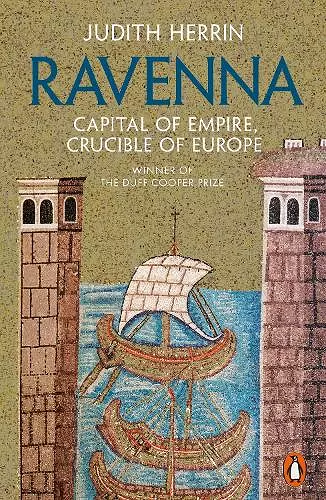Ravenna
Capital of Empire, Crucible of Europe
Format:Paperback
Publisher:Penguin Books Ltd
Published:28th Oct '21
Should be back in stock very soon

'Magisterial - an outstanding book that shines a bright light one of the most important, interesting and under-studied cities in European history. A masterpiece.' Peter Frankopan
'A wonderful new history of the Mediterranean from the fifth to eighth centuries through a lens focussed on Ravenna, gracefully and clearly written, which reconceptualises what was 'East' and what was 'West'.' Caroline Goodson
'A masterwork by one of our greatest historians of Byzantium and early Christianity. Judith Herrin tells a story that is at once gripping and authoritative and full of wonderful detail about every element in the life of Ravenna. Impossible to put down.' David Freedberg
In 402 AD, after invading tribes broke through the Alpine frontiers of Italy and threatened the imperial government in Milan, the young Emperor Honorius made the momentous decision to move his capital to a small, easy defendable city in the Po estuary - Ravenna. From then until 751 AD, Ravenna was first the capital of the Western Roman Empire, then that of the immense kingdom of Theoderic the Goth and finally the centre of Byzantine power in Italy.
In this engrossing account Judith Herrin explains how scholars, lawyers, doctors, craftsmen, cosmologists and religious luminaries were drawn to Ravenna where they created a cultural and political capital that dominated northern Italy and the Adriatic. As she traces the lives of Ravenna's rulers, chroniclers and inhabitants, Herrin shows how the city became the pivot between East and West; and the meeting place of Greek, Latin, Christian and barbarian cultures. The book offers a fresh account of the waning of Rome, the Gothic and Lombard invasions, the rise of Islam and the devastating divisions within Christianity. It argues that the fifth to eighth centuries should not be perceived as a time of decline from antiquity but rather, thanks to Byzantium, as one of great creativity - the period of 'Early Christendom'. These were the formative centuries of Europe.
While Ravenna's palaces have crumbled, its churches have survived. In them, Catholic Romans and Arian Goths competed to produce an unrivalled concentration of spectacular mosaics, many of which still astonish visitors today. Beautifully illustrated with specially commissioned photographs, and drawing on the latest archaeological and documentary discoveries, Ravenna: Capital of Empire,...
Her magni?cent recent book Ravenna: Capital of Empire, Crucible of Europe recaptures the excitement of discovering the history of a city where East Rome and Latin Europe joined for many centuries in ways that defy our neat divisions between ancient and medieval; Romans, Greeks, and barbarians; East and West. -- Peter Brown * New York Review of Books *
Herrin's claims for Ravenna are both sweeping and convincing. ... Herrin's book, then, is about a good deal more than its ostensible subject. It aims to answer some fundamental historical questions. How did the Roman empire in western Europe decay and mutate? What were the influences on the civilisation of medieval Christendom, and how did they interfuse? To what extent was Christianity touched by the trace elements of Greek and Roman civilisation? Notoriously problematic though these issues are, they are ones that Herrin has spent a distinguished career studying, and which Ravenna brilliantly serves to elucidate. -- Tom Holland * Financial Times *
the book is absolutely gorgeous, with magnificent colour reproductions of Ravenna's churches and mosaics. Relics of an age that seems almost impossibly remote, they are the foundations on which modern Europe stands. -- Dominic Sandbrook * Sunday Times *
Beautifully illustrated, impeccably researched and accessibly presented, it traces Ravenna's career as the capital of the Roman empire in the west ... Buildings are also brought to life alongside the people who built and used them. ... It is this linking of tangible remains and historical record that is the book's great strength -- Jonathan Harris * BBC History Magazine *
This book is a triumph of accessible, innovative, lively scholarship from one of the very best Byzantine historians we have. It casts an unexpected but deeply illuminating light on how the "European" political and religious mind became what it is. -- Rowan Williams * New Humanist *
The northern Italian city of Ravenna, with its wondrous mosaicked churches and gilded mausolea that miraculously survived the aerial bombardments of the second world war, was manifestly also a Byzantine city. Herrin shows how this was so in her scrupulously researched history of the city in its imperial heyday through the period Edward Gibbon chose to call the Dark Ages ... eminently worth reading. The colour plates are so sumptuous that the Ravenna mosaics fairly glow on the page. -- Ian Thomson * Spectator *
Judith Herrin's Ravenna ... performs the seemingly impossible task of rescuing its subject from obscurity, charting an improbably journey from marsh-enfolded outpost to imperial capital and cultural dynamo. -- Philip Parker * Literary Review *
Herrin tells the changing story of Ravenna as it unfolds from the end of the fourth century to the ninth in a series of short, accessible sections with the aid of luscious illustrations. -- Averil Cameron * History Today *
Herrin spent nine years researching her narrative of the three and a half centuries of Ravenna's ascendancy ... By the time we can easily visit Ravenna the city again it should be with the advantage of having read Ravenna the book -- Christopher Howse * Daily Telegraph *
lively, startling ... The author evokes lost worlds in surprising anecdotes ... From chariot races to bust-ups between neighbourhood gangs, readers are vividly reminded that for all its grandeur, Ravenna was in its heyday a flawed and hectic place. * Economist *
ISBN: 9780241954454
Dimensions: 197mm x 129mm x 26mm
Weight: 443g
576 pages